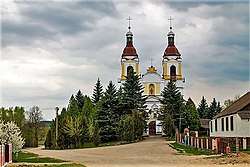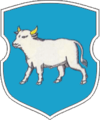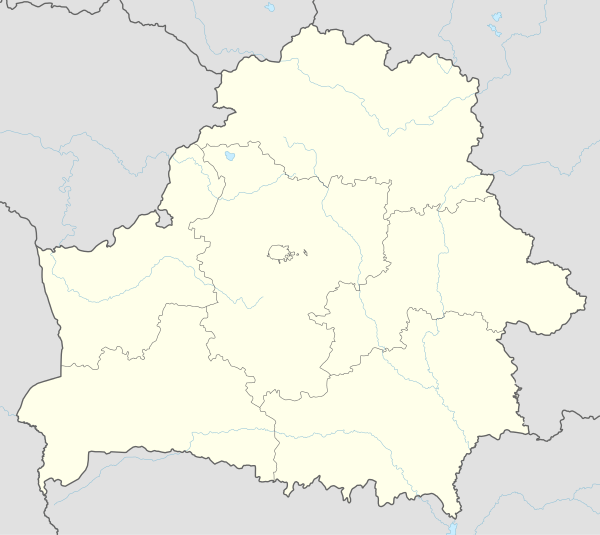Sapotskin
Sapotskin (Belarusian: Сапоцкін, Lithuanian: Sapackinė, Russian: Сопоцкин, Polish: Sopoćkinie, Yiddish: סאַפּעטקין, romanized: Sapetkin) is a small town in Belarus, 27 km (16.8 mi) north-west of Hrodna with circa 2,000 inhabitants. Sapotskin became one of the centers of the Polish minority in Belarus. It is the only town in Belarus where the Polish population, consisting of the majority, was allowed to use bilingual street signs.
Sapotskin Сапоцкін Sopoćkinie • סאַפּעטקין | |
|---|---|
 | |
 Seal | |
 Sapotskin | |
| Coordinates: 53°50′N 23°39′E | |
| Country | |
| Region | Grodno Region |
| District | Grodno District |
| Established | 1560 |
| Area | |
| • Total | 3.736 km2 (1.442 sq mi) |
| Elevation | 203 m (666 ft) |
| Population (2018) | |
| • Total | 977[1] |
| Time zone | UTC+3 (FET) |
| • Summer (DST) | UTC+3 (not observed) |
| Area code(s) | +375 152 |
History
.jpg)
Within the Grand Duchy of Lithuania, Sapotskin was part of Trakai Voivodeship. In 1795, Sapotskin was acquired by the Kingdom of Prussia as a result of the Third Partition of Poland and incorporated into the New East Prussia Province.
From 1807 until 1815, Sapotskin was part of Lomza Department of the Grand Duchy of Warsaw.
In 1815, Sapotskin was acquired by the Russian Empire. Within the Russian Empire, the town was successively part of Augustow Voivodeship (1815-1837), Augustow Governorate (1837-1867) and Suwałki Governorate (1867-1915) before German occupation between 1915 and 1918.
From 1921 until 1939, Sapotskin was part of the Second Polish Republic. It was a gmina centre in the Augustow powiat of Białystok Voivodeship.
In September 1939, Sapotskin was occupied by the Red Army and, on 14 November 1939, incorporated into the Byelorussian SSR. The area became part of the Belastok Region of the Byelorussian SSR, with Sapotskin as a regional centre.
From 22 June 1941 until 18 July 1944, Sapotskin was occupied by Nazi Germany and administered as a part of Bezirk Bialystok. In 1941 and 1942 nearly the entire Jewish population of Sapotskin was murdered by Nazi forces in the Holocaust. A memorial book[2] about the town's Jewish shtetl was translated into English.[3]
Sapotskin was liberated by the Red Army on 18 July 1944. The town became a regional centre of Grodno Region.
Old photographs of the town have been collected.[4]
Notables
- Sapotskin is the death place of Gen. Józef Olszyna-Wilczyński and his adjutant, murdered by Soviet soldiers
- Yaraslau Ramanchuk, a Belarusian economist and 2010 presidential candidate, was born in Sapotskin
Attractions
- Burial mound (10-11 cent.) - archaeological monument, on the western outskirts
- Church of the Assumption of the Blessed Virgin Mary (early 20th Century)
- Sapotskinsky Biological Reserve (Augustów Canal)
References
- Численность населения на 1 января 2018 г. и среднегодовая численность населения за 2017 год по Республике Беларусь в разрезе областей, районов, городов и поселков городского
- Manor (Menschinsky), Alexander. "Sopotkin; in Memory of the Jewish Community (Belarus)". Retrieved 13 February 2016.
- "Sopoćkinie | Virtual Shtetl". sztetl.org.pl. Retrieved 2019-08-31.
- Gliński, Mikołaj. "Phantom Snapshots from the Polish-Belarusian Border". Retrieved 13 February 2016.